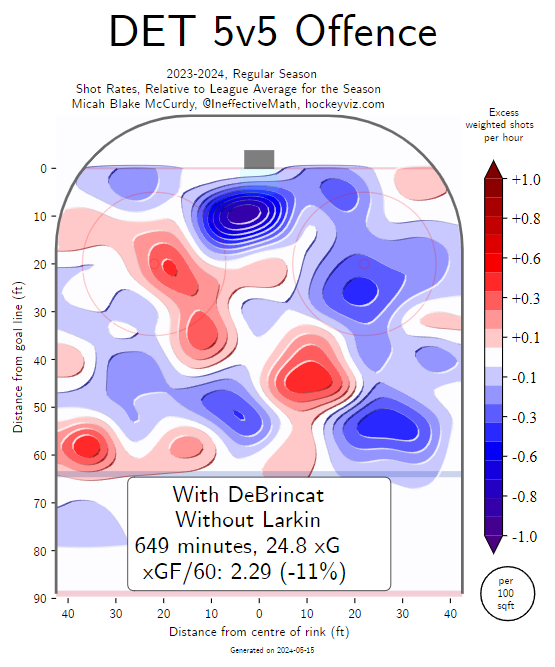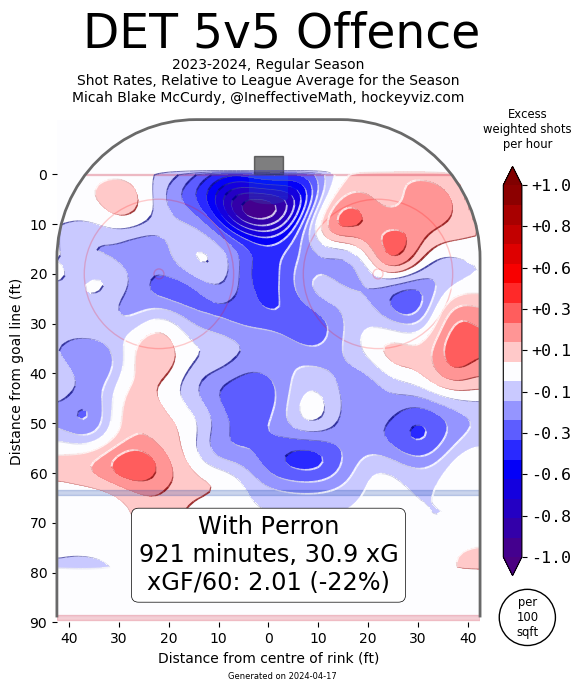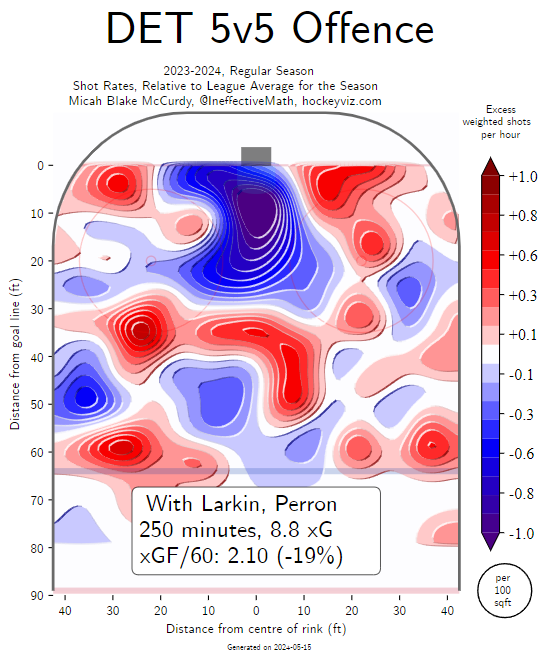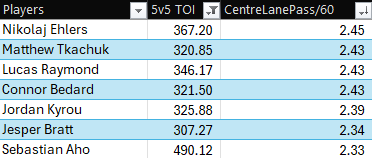San Jose Sharks reported Sheng Peng indicates that prospect Will Smith may sign with the Sharks this summer. Smith was taken fourth overall in the 2023 Draft and would pair very nicely with the incoming Macklin Celebrini. We’ll cover it more when it happens, but Peng is a very good reporter so there shouldn’t be much doubt about if it will happen. Things can change, of course.
*
Dallas fought back from a 2-0 deficit to Edmonton to defeat the Oilers 5-3 in Game 3. The win gives the Stars a 2-1 series lead and it could prove a pivotal turning point not only in this series, but in this franchise's future.
Edmonton carried a 2-0 lead into the second period and then Dallas scored three goals in under four minutes – two from Jason Robertson and one from Wyatt Johnston – to take the lead. Adam Henrique tied things up late in the frame, but Robertson finished his hat trick in the third period while Miro Heiskanen added an empty netter. This was a game Edmonton should have clearly carried over the finish line and it might end up being a game where a sub-4 minute stretch alters the future of the NHL.
Robertson's hat trick doubled his entire playoff goal total while Jamie Benn and Tyler Seguin had a pair of helpers. Roope Hintz returned to the lineup and had a pair of assists of his own.
Connor McDavid had a goal and an assist while Zach Hyman scored his 13th goal of the postseason.
Jake Oettinger stopped 28 of 30 shots in the win.
Game 4 is Wednesday night back in Edmonton.
*
We are down to the final two teams in my offseason reviews of the 16 non-playoff squads and today's team is one that fell apart at the end of the season to miss the playoffs yet again with the Detroit Red Wings. We have already gone over the San Jose Sharks, the Chicago Blackhawks, the Anaheim Ducks, the Columbus Blue Jackets, the Montreal Canadiens, the Arizona Coyotes (now in Utah), the Ottawa Senators, the Seattle Kraken, the Calgary Flames, the New Jersey Devils, the Buffalo Sabres, the Philadelphia Flyers, the Minnesota Wild, and the Pittsburgh Penguins.
Data from Natural Stat Trick, Evolving Hockey, HockeyViz, and Frozen Tools with salary cap data from Cap Friendly. Any tracking data is from AllThreeZones unless otherwise noted.
What Went Wrong
It is a weird year for Detroit because they finished tied for 10th by goals per 60 minutes at even strength, eighth by goals per 60 minutes on the power play, and finished ninth overall by goals per 60 minutes. Despite that, they had one player reach 70 points (Lucas Raymond, 72), had no player reach 35 goals (Dylan Larkin led with 33), and only had three forwards with 50 points. Of course, had Larkin played a full season – he had 33 goals and 69 points in 68 games – things would look different, but he didn't, so it doesn't.
The big reason for that is no player managed a point on 75% of the team's goals scored with them on the ice, and only three were over 66%: Patrick Kane, Daniel Sprong, and Raymond. Kane played just 50 games, Sprong was a depth player, and Raymond ended up leading the team in points. They had no players in the true upper-echelon of goal involvement, and two of the players in the next tier down either missed a ton of time (Kane) or didn't get many minutes (Sprong). Even Raymond finished under 18 minutes a game, so he could have been an 80-point player with 19-20 minutes a night.
Alex DeBrincat was the big letdown. In 2022-23, he had 27 goals and 66 points in a down year with Ottawa. Going to Detroit to join Larkin and Raymond, and with Kane signed, the expectation is he would return at least to 30 goals, and maybe crack 40 again as he did twice in Chicago. He ended up with 27 goals again, and increased his point production from 66 to *shuffles notes* 67. He saw a big drop in power play points (30 to 19) and hits (109 to 66) with modest drops in shots (263 to 237) and penalty minutes (45 to 34). Considering the expectations, being worse than he was in Ottawa for multi-cat fantasy leagues was an underperformance.
To start with, ice time was a problem. He skated 17:54 per game, his lowest in four seasons after three straight years of 19 or higher, and back-to-back seasons between 20:30 and 21 minutes in Chicago. Those two years with the Blackhawks saw him skate 20:44 per game, so he dropped nearly three full minutes from those seasons to his first year with Detroit. As with any player, a huge drop in ice time is going to hurt peripherals, if not production, and that's what happened.
The big problem for DeBrincat mirrored what happened with Erik Karlsson in Pittsburgh: a lack of depth scoring crushed his 5-on-5 production. Here is how the team fared, shots-wise, with DeBrincat on the ice without Larkin:

With Larkin on the ice at 5-on-5, DeBrincat posted 3.3 points per 60 minutes. It is an absolutely preposterous number that, over a full season, would have had him among the elite in the league. We're talking Nikita Kucherov/Connor McDavid-type production. However, with Larkin off the ice, that number cratered to 1.4 points per 60 minutes. That gap is the difference between Nathan MacKinnon levels of point production and Jimmy Vesey levels of production. It isn't all on the depth – we just went over how well Sprong did this season – but it does speak to the larger problem with the Red Wings: after Larkin and Raymond, there just isn't much to play with. Guys like Andrew Copp, David Perron, JT Compher, Joe Veleno, and Robby Fabbri aren't good enough to help guys like DeBrincat sustain reasonable production in second-line minutes.
We may have seen the end of the road for Perron. His 0.62 points per game was the lowest for him since 2017, and it's now three straight seasons of a declining point rate. It is also a third straight season of declining ice time totals, so there's a chicken/egg situation going on here, but if he's a 15-minute winger rather than a 17-minute winger, the hopes of 60-point seasons are a thing of the past.
The big problem for Perron is that he wasn't helping drive production and if he's not doing that, he doesn't have enough defensive value for the coach to justify heavy usage. To put a finer point on it, here is what the team did offensively with Perron on the ice at 5-on-5 (blue is bad, and the darker the blue, the worse it is):

This is a team that thrived on quality over quantity, but at a certain point, being so far below the league average by shot/expected goal generation is going to crush the offence. He couldn't even make it work in his ice time with Larkin, either:

If he can't make it work with Larkin, leaving the coach to drop him off the top line, there's just not much elsewhere on the roster for Perron to play with. He might still help a bit on the power play, but that's about it.
Lastly, the goaltending was a problem. Ville Husso lost his job entirely (both injury- and performance-related) and both James Reimer and Alex Lyon managed .904 save percentages with goals against averages of 3.11 and 3.05, respectively. The team was desperate for a postseason appearance and thus split time with whomever was playing well at any given moment. Both Husso and Lyon are signed for 2024-25 and the team will be no less desperate for a postseason appearance. It makes this a very precarious situation to rely on any one goalie for fantasy value, and they may even go shopping for another one in the offseason.
What Went Right
We will call Larkin's season a success, but it might depend on the league he was rostered in. A full season would have seen him push (or pass) 40 goals, 80 points, 30 power play points, and likely set a five-year high in shots. On a per-game basis, he was very good. However, he missed nearly three weeks in March and that was around the start of head-to-head fantasy playoffs. There is a good chance that he was out for at least the first week of the H2H postseason and he's not a replaceable player, so there are fantasy owners cursing his name even if he was very good for five months.
One thing Larkin helped Detroit do was push the pace. The team averaged 6.7 rush contributions (shots and assists on teammate shots) per 60 minutes at 5-on-5. Only three players exceeded that number by at least 30%, and one of them was a depth forward:

Larkin had the team's highest rate of scoring chance assists at 5-on-5 (helpers on teammate chances), was second by carry-in percentage of zone entries (Sprong led), and was second in total zone entries per 60 minutes (Raymond was first). When looking at those things, as well as chances created off their carried zone entries, Larkin compares closely with three forwards that were also the focal point of their respective team's offence (for better or worse):

A full season from Larkin would have seen him have a very good multi-cat season, especially where he skated a three-year high of 20:10 per game. Until the team gets a second-line centre that can actually drive the offence, that will continue to be the case.
The big note from this season was Lucas Raymond with his 31 goals, 72 points, 16 power play points, and 69 hits. As I've often stated, I didn't think he had that high-end level of offensive upside in him, and he showed this season that he absolutely does. At 5-on-5, one thing he did very well was drive the middle, and it led to him having very high assist rates from the middle of the ice. Tracking data has the league average pass rate from the middle at 1.2 per 60 minutes of 5-on-5 play. Of the 292 forwards with at least 200 tracked minutes, the elite like Connor McDavid and Mark Stone were over 3.5 per 60 minutes. The next tier down, though, had a lot of high-end forwards and there we find Raymond:

Raymond didn't have high-end assist rates on teammate scoring chances, but he also didn't make a habit of wasting his playmaking, either. His rate of passes from behind the net, across the seam, or from the middle was just outside the first standard deviation of the league average, or easily a top-line rate. He wasn't just feeding the puck to the blue line or otherwise throwing the puck away, and it helped drive dangerous chances for his team. It is probably why he was the only one out of himself, Kane, DeBrincat, and Perron to be able to maintain even league-average scoring rates away when playing without Larkin.
It is just one season but another season like this and we're looking at a bona fide top-line scorer and a guy that is probably a point-per-game winger sooner rather than later. It would help if the team started using him like it, though, as his 17:45 per game had him outside the top-100 forwards by per-game usage, and it's lower than his rookie season. It is notable that he skated 18:54 per night over his final 20 games, though, and that is likely closer to what we should expect in 2024-25. A full season from Larkin puts point-per-game potential on the table for Raymond.
All told, Shayne Gostisbehere's 10 goals, 56 points, and 29 power play points was a successful fantasy season. However, as his ice time has declined over the last couple of seasons, his peripherals have, too: each of his totals of 139 shots, 29 hits, 75 blocks, and 16 penalty minutes were three-year lows. Being able to pass 50 points is great, but in multi-cat formats, a total of 243 hits, blocks, and shots just isn't very much. He is a free agent this summer, so we'll talk more about it when he signs back in Detroit (or elsewhere).
Moritz Seider had another fantastic multi-cat season. His nine goals were a career-high, he crossed the 40-point mark again (42), he had 17 power play points despite the acquisition of Gostisbehere, and he put up a whopping 213 blocks and 211 hits. A big note here is that he has now played all 82 games for three straight seasons. That he plays such a physical style – he also had a career-high 51 PIMs – and can keep himself on the ice is a very good sign for his fantasy value. He may not end up a 70-point defencemen in the seasons to come, and the shot rate has now declined each season he's been in the NHL, but if he can put up 40 points with those levels of blocks and hits, multi-cat fantasy owners probably don't care.
Where They Go From Here
It is an interesting time in Detroit. They have $29M in cap space, but both Raymond and Seider need new contracts. Evolving Hockey's contract projections have them both expected to sign longer-term deals (at least six years) with cap hits between $7.5M-$8M. That seems fair, but it would also cut their available cap space by more than half. In other words, that $29M in cap space is more like $14M in cap space.
That $14M in cap space is notable because once they sign Raymond, they'll have just seven forwards signed. They probably don't re-sign Perron, but Kane and Sprong could very well come back. Those two guys returning would probably eat close to half that remaining $14M in cap space. In other words, that $29M in cap space, assuming they bring back all of Raymond, Seider, Kane, and Sprong, is more like $7M in cap space. They probably want more depth in net and a low-dollar signing there, plus Marco Kasper, Simon Edvinsson, and Axel Sandin-Pellikka would eat most of that cap space.
All that is to say that while the team has $29M in cap space, bringing back their young core, extending a couple of important veterans, and graduating other prospects might bring that $29M in cap space to just a few million. It really doesn't leave them much room to make genuine upgrades in free agency.
If Detroit does make any significant upgrades, it is almost certainly through an impact trade by sending out one of Edvinsson or Sandin-Pellikka. Attach one of them with someone who has a moderate salary – Olli Maatta makes the most sense, given his lack of trade protection – add a second-round pick, and go get an impact RFA. Easier said than done, of course, but it seems the most likely course to make a genuine upgrade to the existing roster.
If Detroit doesn't make any significant changes, it puts a lot of pressure on guys like Kasper and Edvinsson to not only be regular NHLers, but impact ones, if the team wants to get back to the postseason. It should be a fascinating offseason in Hockeytown.
Larkin and Raymond are top-100 fantasy picks, Seider is the same in multi-cat formats, and DeBrincat probably joins that group. Until we see if (when) they make a big trade, we'll hold off on extending much fantasy relevance to other players, but there are both veterans and prospects that should make fantasy owners in any format intrigued in this offence.
One Comment
Leave A Comment
You must be logged in to post a comment.





 CHI
CHI BUF
BUF NYR
NYR TOR
TOR ANA
ANA PIT
PIT N.J
N.J L.A
L.A DET
DET CAR
CAR

Why do you say the 4 minute stretch where Dallas scored a couple goals could alter the future of the NHL?